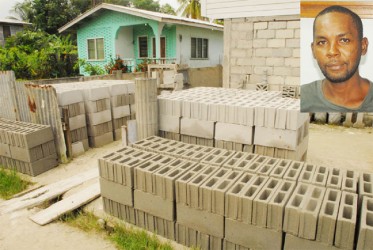These ought to be good times for Wayne Garraway. He has spent almost half of his 38 years in the hollow block business. His 389 Cemetery Road, Mocha Cement Factory manufactures cement blocks and Garraway himself has, over the years, developed considerable expertise in decorative blocks, spindles and concrete columns.

The hollow block industry is widely believed to be a lucrative sub-sector of a building sector that is in the throes of a boom. Still, Garraway says, times are tough. The construction sector, lucrative as it may seem, has become more competitive and more clannish.
When Stabroek Business spoke with Garraway earlier this week he was stockpiling blocks at his factory. There were no orders to fill but he was hoping to be ready in the event that he received a call.
The market is a complex one. Garraway says the businesses that do best in the construction sector are those “with connections.” All too often, long before a major project commences, decisions are made on who gets what. Garraway concedes that in the trade “you have to be well-connected.” When the calls don’t come Garraway makes trips to work sites himself. Invariably it’s the same story: they have the blocks covered. An investigation is likely to find that the supplier is a friend of a friend.
Garraway says that if perchance a contractor agrees to do business, he attempts to “push you down” below the prevailing market price. The current market price for hollow blocks is $80 each. Garraway says that if a contractor senses that a supplier is desperate for a sale he would not hesitate to push the price down. The numbers suggest that the trade is no bed of roses.
Garraway says that in 2004-2005 cement was sold at $800 per sack and sand was $5,000 per ten ton. During that period the asking price for a concrete block was $50. Today with both cement and sand prices having increased almost threefold, block makers still get less than double the price they received eight years ago.
Garraway says it is the buyer who holds the whip hand in the block market and he has come to terms with that. He says that like other small proprietors he steers clear of the major contractors and the official tenders. His patronage comes mostly from small communities like the one in which he works. He wishes that there were bigger opportunities for small businesses like his own but he is not allowing that to preoccupy him.
“I’m a hustler and this is what you have to expect,” he says.
He takes pride in his professionalism. He talks about what he says is a tendency in some quarters of the industry for sub-standard work. He has gone to work sites seeking contracts and has seen huge piles of concrete waste; blocks that have crumbled. “Choices do not always depend on quality. Sometimes these things are about deals,” Garraway says.
He talks concrete with an air of authority. A sack of cement, he says, should yield 20 4x8x16 blocks; 22 6x8x16 blocks or 33 3x8x16 blocks. If the numbers are higher the blocks are probably sub-standard. The problem is, he says, that where standards monitoring mechanisms are limited “you can always buy cheaper blocks of lower quality.”
The best product, he says, usually comes from a thoroughly brewed mix of cement and sand where sufficient water is added to hold the mixture together. The thorough brewing or mixing is necessary to avoid significant pockets of pure sand which will almost certainly cause the block to crumble.
Garraway started out in the block making business in 2000 but had to quit temporarily in 2007 after having to give up his rented Charles Street, Charlestown premises. He occupied his current factory in 2012.
Garraway is determined to stay with the trade though he pauses thoughtfully when asked about the prospects for expansion. Eventually, he responds. “Capital,” he says. Garraway, like so many other small Guyanese businessmen continues to be wary of a commercial banking system whose gingerly steps into the world of small business lending are still not enough to lift the spirits of small entrepreneurs who remain unsure about whether commercial banks want to do business with them or not.






